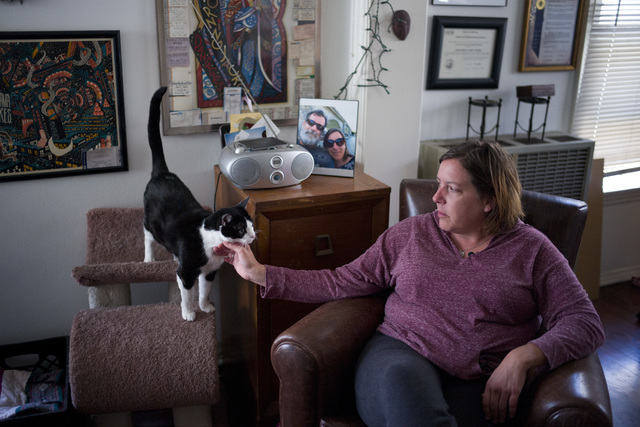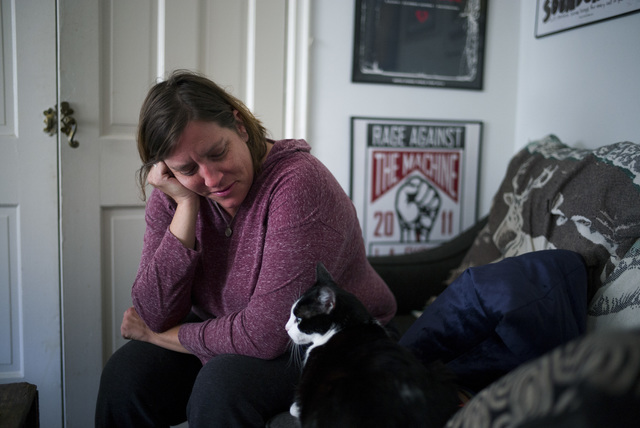After San Bernardino, counselor faces other side of crisis

ASSOCIATED PRESS
A framed photo of Mandy Pifer with boyfriend Shannon Johnson is seen as Pifer pats her cat in her apartment in Los Angeles on May 22. Nearly six months ago, Johnson was one of the 14 people killed in the San Bernardino terrorist attack. She was a couple’s therapist who also volunteered with the mayor’s crisis response team but hadn’t returned since the shootings. Now she is returning to her work, intent on paying forward the support shes received.

ASSOCIATED PRESS
Mandy Pifer looks at her cat while resting in her apartment in Los Angeles on May 22. Nearly six months ago, Pifer’s boyfriend Shannon Johnson was one of 14 people killed in the San Bernardino terrorist attack. As a responder with the Los Angeles mayor’s crisis response team, Pifer has spent the last six years comforting others in the aftermath of tragedy. But after the attack, Pifer found herself dealing with a crushing, overwhelming sadness.


LOS ANGELES » Mandy Pifer drove to the Los Angeles Police Department last week and prepared to face a fresh wave of grief.
Pifer, a crisis counselor, has spent the last six years comforting people in the aftermath of death. The woman whose sister killed herself with an electric chainsaw. The 8-year-old girl who found her mother shot to death on their couch.
The grief she was preparing to encounter was her own.
Nearly six months ago, her boyfriend Shannon Johnson was among the 14 killed in the San Bernardino terrorist attack. Grappling with the anguish, she left counseling to mourn, retreating into her Koreatown apartment filled with their photographs.
Driving to the LAPD office to meet with her crisis team colleagues, she imagined seeing many friends for the first time since the attack would bring the entire ordeal back. She wanted to return, but she also wondered how she would react.
Was she ready to go back behind the yellow tape?
Don't miss out on what's happening!
Stay in touch with breaking news, as it happens, conveniently in your email inbox. It's FREE!
—
Pifer was one year out of a long-term relationship when she decided to give online dating a try. Johnson’s profile picture immediately attracted her. He had a warm smile and his orange tabby, Jerry, peeked over the side of one shoulder.
They started chatting and quickly, decided to meet.
For their first date, they decided to meet at Union Station in downtown Los Angeles. Inside its towering, ornate marble halls, they talked about growing up in the South — he in Georgia, she in Tennessee — and moving to California as adults.
Johnson wasn’t like people she had dated before. He had full sleeves of tattoos and had spent 10 years traveling across the country as a truck driver. At 42, he was also twice divorced. Both, she said, had barriers up.
Johnson wasn’t afraid of marrying again, but he also didn’t want to another divorce, she said. Pifer feared getting hurt, terrified of falling in love with him.
“It was the scariest experience of my life. I used to tell him it felt like I was hanging on to the edge of a great, deep pit,” Pifer said.
Six months later, Pifer was on the hunt for a new apartment. A studio across from Johnson’s apartment in a pre-War Koreatown building opened up.
He told her she should move in.
—
Pifer first learned about the mayor’s crisis team when she was a graduate student studying clinical psychology. A friend passed along a police bulletin calling for volunteers to respond to homicides, suicides and death notifications.
“I remember thinking, I want to do that,” Pifer said. “Somebody has to.”
Soon enough, she had graduated from training and was crossing behind the yellow tape at some of the most grisly scenes in Los Angeles. Her job: To counsel those who have no one — no relatives, no friends — there to console them.
There are dozens of calls that linger in her memory. The first time she smelt death. The first time she had to leave a scene and walk around the block to compose herself. The first time she accompanied the police on a death notification.
“I learned to never be looking someone in the eye when they receive news that their loved one had died,” she said. “Because I saw their heart break.”
—
On Dec. 2, 2015, Pifer woke up and found a text from Johnson.
“Have a great day,” he wrote. “I love you.”
By that time, Pifer and Johnson had been together three years. Their belongings were now equally scattered across both apartments: One affectionately known as the couple’s “West Wing,” the other their East.
Johnson worked as a health inspector in San Bernardino, an expansive, mountainous county to the east of Los Angeles he commuted to daily. That morning, he’d left extra early to make it to his department’s holiday gathering.
The two imagined moving out to the desert when Johnson retired in another 10 years, or maybe, returning to the South. On his computer that morning, Pifer found an internet browser opened to a page showing properties for sale in Georgia.
Pifer was meeting with therapy clients when the first reports of an active shooter in San Bernardino came in.
She sent Johnson text messages. No replies.
When Pifer called the crisis team’s director that afternoon, he assumed she was offering to help console survivors and victims’ families.
“No, no, no,” she told him. “I can’t get a hold of Shannon.”
Then, as she was driving home, she listened to the radio and heard that the shooting had happened at a meeting for Environmental Health Department workers.
Pifer immediately pulled over.
She knew.
—
In his last moments, Johnson had huddled with a colleague, 27-year-old Denise Peraza, under a table, shielding her from a flurry of bullets, she said. “I got you,” he told her — a phrase that became a trending hashtag on social media. Pifer started making plans to start a foundation to spread Johnson’s message of compassion.
There were interviews with reporters, calls from politicians and a hug from President Barack Obama.
It all passed like a blur. Adrenaline coursed through her body.
She wasn’t in denial, but as a crisis counselor used to consoling others, she perhaps wasn’t certain how to grieve her own loss.
She kept thinking about the other families. She arranged for therapeutic miniature horses to visit the other bereaved relatives and his traumatized co-workers. She remembers feeling pressed to make sure the families were getting the services they needed.
Then, three months later, the anguish hit.
“Getting out of bed,” she said, her voice trailing. “I just didn’t do it.”
It’s now been another three months and, maybe, the pain is letting up a bit. She can now listen to the songs on Johnson’s iPhone playlist that hummed like a soundtrack in the background of their lives together. She wants to return to work.
Still, the grief comes in jarring waves of pain, with triggers she is still learning to detect.
—
Pifer turned off her car’s ignition outside the LAPD office.
She exited her car and made her way through the haze of Koreatown at sunset. She climbed up the stairs to the police bureau and immediately spotted an old friend. Burnett Oliver wrapped her in a bear hug. Pifer wept.
“Give it time,” he told her as he patted her on the back.
She picked up all the papers she needed filled with resources for victims. Two days later, she was back on the roster — signed up for an overnight on-call shift from home. She still wasn’t exactly sure how she’d feel going out to a police scene but something had changed.
“I realized that, you know, I need to go back, because a large part of my identity is helping others,” she said. “I refuse to live in a world of fear.”
As she got ready for bed, she kept her fully charged phone nearby. A photo of Johnson in a frame with the word “Love” rested on her nightstand.
She waited for the phone to ring.
—
Follow Christine Armario on Twitter: http://www.twitter.com/cearmario



